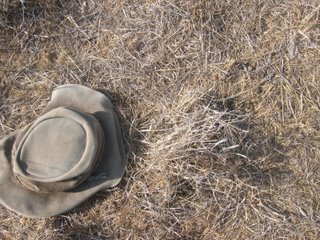 (THIS IS US AS WE APPEARED IN THE MUDGEE GUARDIAN'S WEEKLY EDITION)
(THIS IS US AS WE APPEARED IN THE MUDGEE GUARDIAN'S WEEKLY EDITION)  (THIS IS DANIEL CATCHING A MEAL ON THE RUN DURING OUR MARATHON CERTIFICATE-A-THON)
(THIS IS DANIEL CATCHING A MEAL ON THE RUN DURING OUR MARATHON CERTIFICATE-A-THON)We can now afford to feed our flock for two more months - 2/3rds of our target commitment of 100 days. Meanwhile the rain has come - nearly 45mls in the past 3 days. We'd forgotten what it looks like. It looks like this: ((((RAINDROP)))) ((((RAINDROP)))) ((((RAINDROP)))) ((((RAINDROP)))) ((((RAINDROP))))((((RAINDROP)))) ((((RAINDROP)))) ((((RAINDROP)))) ((((RAINDROP)))) ((((RAINDROP))))((((RAINDROP)))) ((((RAINDROP)))) ((((RAINDROP)))) ((((RAINDROP)))) ((((RAINDROP))))((((RAINDROP)))) ((((RAINDROP)))) ((((RAINDROP)))) ((((RAINDROP)))) ((((RAINDROP))))((((RAINDROP)))) ((((RAINDROP)))) ((((RAINDROP)))) ((((RAINDROP)))) ((((RAINDROP)))) ((((RAINDROP)))) ((((RAINDROP)))) ((((RAINDROP)))) ((((RAINDROP)))) ((((RAINDROP))))
We need that much every week for the next 6 months to fill the dams and soak the soil down deep to reignite the cation exchange process (the electrical process that soils use to transfer nutrients to roots).
The soil is waiting for rain. If we 'eat out' the paddocks, there will be nothing to hold the soil together. It will be bared to bake in the sun (and release large amounts of the greenhouse gas CO2). There will be only a hard surface to greet the rain, which will run off into the dams and waterways, carrying our most precious resources - topsoil. By retaining groundcover, we not only protect the soil, we prepare the ground to recieve the water and draw it down into the rootmass which will be the engineroom of growth for the new vegetation. There is a world of bugs and microbes and fungi and microfauna down there, dormant and just hanging on for the rain. They spring to action when rain arrives. But there's a more important reason to give paddocks a good rest from grazing - it's that the grasses will grow even when there's no rain. ALl they need is time.
This is bare earth.
 (THIS IS BARE EARTH. WHICH IS BAD. IT BREAKS DOWN UNDER THE HEAT AND BLOWS AWAY. OR IT PRESENTS A HARD SURFACE TO THE RAIN WHICH MAKES IT HARD TO SOAK IN.)
(THIS IS BARE EARTH. WHICH IS BAD. IT BREAKS DOWN UNDER THE HEAT AND BLOWS AWAY. OR IT PRESENTS A HARD SURFACE TO THE RAIN WHICH MAKES IT HARD TO SOAK IN.)This is a little ground cover. Probably not enough, but it protects the communities living just beneath the surface of the soil.
 (THIS IS SOME GROUNDCOVER, ENOUGH TO HOLD THE TOPSOIL TOGETHER AND STOP WATER JUST RUNNING OFF AND NOT SOAKING IN.)
(THIS IS SOME GROUNDCOVER, ENOUGH TO HOLD THE TOPSOIL TOGETHER AND STOP WATER JUST RUNNING OFF AND NOT SOAKING IN.) (THIS IS BETTER GROUNDCOVER DURING DROUGHT BECAUSE IT PROTECTS THE SOIL FROM THE WORST OF THE HEAT AND THE ROOTMASS IS LARGER AND READY TO SOAK UP THE RAIN)
(THIS IS BETTER GROUNDCOVER DURING DROUGHT BECAUSE IT PROTECTS THE SOIL FROM THE WORST OF THE HEAT AND THE ROOTMASS IS LARGER AND READY TO SOAK UP THE RAIN)This rain is a blessing. Now we need time for the grasses to respond. And they a responding. Within 24 hours of the first fall the green started to appear. This is becuase we have some rootmass retained because we took the animals off the paddocks before theyw ere bared out. The paddocks that are eaten down to billiard table smoothness will take far longer to respond, the grasses will be sparcer, and will have far more weed infestation. (Weeds love bare earth.)
Why do weeds love bare earth? Because they thrive when they have no competition from sturdy grasses and shrubs. You see, grass and weeds don't just grow in any place at any time. When you know the lifecycle behaviour of plants you can read a patch of ground like a book... A heavy infestation of weeds is not necessarily a bad thing because weeds have a role to play and a time to play it. Weeds are opportunistic - they take hold whenever they get a chance. We'll talk about weeds later.




1 comment:
Hi,
I've just finished reading this whole page from April down to the beginning. It facinating to see how simple concepts can work so well. I appreciate the way you provide the detail on how the process of retaining grasses, roots, water, microbes and top soil occurs. Mentioning things like Cation reall hooks people into this world which is very rarely explained to people, or from what I can tell, known by many farmers. I live in the outskirts of Sydney and will adapt these sorts of concepts to gardening in urban life.
Post a Comment